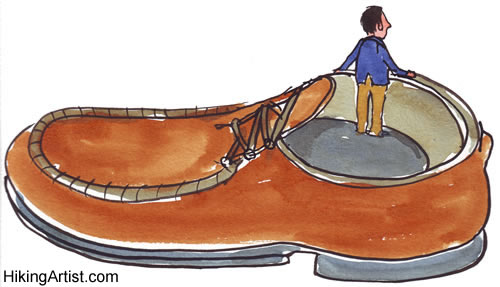|
|
|
Thursday, November 15th, 2018

As I was going through my plans for a post this week, I realized a great one had already been written. My company promotes our employees both internally and externally. They shine a positive spotlight on my team mates and I wanted to highlight someone I work with everyday.
Below is a link to her story.
Endless Opportunities
Image credit: Gayle Nicholson
Posted in Culture, Personal Growth, Ryan's Journal | No Comments »
Friday, November 9th, 2018

A Friday series exploring Startups and the people who make them go. Read all If the Shoe Fits posts here.
How do you give your team the greatest chance to succeed?
By creating a supportive culture, instead of a judgmental one.
It’s not rocket science.
Just common sense.
Unless you actually believe you are Steve Jobs/Jeff Bezos/Mark Zuckerberg.
Then you can get away with acting like a jerk.
But you better be sure.
Very, very sure.
Image credit: HikingArtist
Posted in Culture, Entrepreneurs, If the Shoe Fits | No Comments »
Tuesday, September 8th, 2015

Good bosses work hard to provide a positive culture where their people can learn, grow, make a difference and build a career to be proud of.
Most cast a wide net to find role models and use what they learn to improve their organization.
Sports has provided many of these role models, but most are the tough-talking, in-your-face style that many managers and most workers don’t like.
But Pete Carroll, Coach of the Seattle Seahawks, takes a different approach.
“Football has an old-school mentality: We’re going to grind you into the ground, we’re going to make men out of boys, and when you do something bad, we’re going to demean you. But here, they feel like you guys are already men and we’re going to treat you like men. It’s literally all positive reinforcement.” — Jimmy Graham, all-star tight end
And it’s not a when-times-are-good attitude that falls by the wayside when adversity hits — as it always will.
Even the intercepted pass that cost the Seahawks the Super Bowl last year didn’t rattle or change Carroll’s approach.
In his five years leading the Seahawks, he has made a mark not just by winning games but by reshaping the role of N.F.L. coach. Carroll, 63, has embraced diversity, encouraged free expression, promoted self-discovery and remained relentlessly positive.
Just think what your team could accomplish if you choose to emulate Carroll, instead of the more typical coaches.
Flickr image credit: Mark Lee
Posted in Culture, Ducks In A Row | 1 Comment »
Thursday, May 28th, 2009
In Richard’s interview with Pat Lynch regarding the EFCA, she said that employers have a choice, either take care of their people or the unions will. Lynch identified four primary issues on which employees rate their job satisfaction:
- Employee satisfaction with immediate supervisor
- Employee voice – do employees feel safe in challenging the status quo, do employees believe their ideas will be considered
- Employee perceptions of procedural fairness
- Rewards and recognition – these go far beyond compensation, which is not a significant element of satisfaction. Recognition is extremely important.
Richard suggested to start with an online satisfaction survey to learn how employees perceive management and the company and then to act on the results.
 He also said, “come back Thursday to hear Miki’s take on keeping employees happy,” which isn’t really fair since everything I write is about keeping them happy and I even have a post called that. He also said, “come back Thursday to hear Miki’s take on keeping employees happy,” which isn’t really fair since everything I write is about keeping them happy and I even have a post called that.
But I’m committed, so let’s do this again.
In today’s language, ‘happy’ means ‘engaged’, which isn’t a new topic—think buy-in, ownership, commitment, involvement, etc.
Although the terms keep changing the behavior has been consistently on management’s radar for decades. The funny part is that the way to achieve it is as old as humanity and ties directly to the Lynch’s four issues.
The big four of engagement are
- respect;
- encouragement;
- support; and
- rewards.
Although descriptions and phrasing may vary, when all is said and done it always comes down to these four basics.
It’s not as if this is secret management knowledge. There are thousands of books, hundreds of classes, dozens of blogs and forums all teaching variations on this theme. I read a good article on it last year, but it was the comments that had the real value.
The real question then is if it’s that simple, why isn’t it put into practice more often?
MAP (mindset, attitude, philosophy™) is the reason. MAP shapes a person’s actions
- If you don’t really believe in the value or numbers 1 or 2, you can talk all day and your people will hear what you say as hollow, i.e., no authenticity.
- Number 3, support, includes skills training and career development. Ingenuity. Not just yours, but your group’s. Your people aren’t dumb, they know when the company can’t/won’t fund training, but there are tons of ways work around that, such as sharing their own expertise with each other during organized brown bag lunch sessions.
- Number 4 usually involves money, but public recognition often ranks higher on the scale. And when there’s an authentic, provable lack of funds to provide significant rewards, every company can find other ways to prove that they value their people’s contributions.
There’s a final component that needs to permeate all ranks of management, it’s what I call the believability factor, BF for short.
Believability is a two-edged sword. A strong BF draws people to you; it helps them hear what you have to say; see the vision that you present; and underscores their willingness to follow your lead. Without it, even the straightest shooters may be casually dismissed.
The flip side is definitely worse, because con people, crooks and even murderers often have BF in abundance.
If you’d like to learn more about how to evaluate your own BF and change it if you so desire, read MAP your BF—at work, at home, even in the bedroom!
In short, keeping people happy means embedding this stuff deep within your culture, because it can’t be faked or implemented in a couple of weeks.
That’s it; it’s not rocket science, but must be done from the top and every level down consistently, sincerely and with great enthusiasm.
Image credit: soul2love on flickr
Posted in Business info, Culture, Motivation | No Comments »
Tuesday, February 24th, 2009
 You’re swamped with advice from a wide variety of experts, gurus and pundits on how to survive the downturn in 2009, You’re swamped with advice from a wide variety of experts, gurus and pundits on how to survive the downturn in 2009,
- Increase spending on R & D. Now is the time to build your product portfolio for the upturn in 2010.
- Increase your spending on marketing. Now is the time to build your brand.
- Increase your investment in sales. Now you can steal market share from competitors.
- Employees are your greatest asset. Nurture them.
Given that wonderful advice, don’t you feel foolish looking at a 25% revenue decline and corresponding expense reductions. Somehow the economic and business pundits still know best how to spend your money, in spite of their forecasts that just continue to get it wrong.
As the person in charge, you know that you have to reduce spending somewhere, somehow. So the question is not how to spend more money, but how to make spending cuts. One possibility:
Cut spending strategically.
Use Hard Choices to Sharpen Your Focus
In difficult times, where you cut spending may be the most important decision you make. The cuts demonstrate dramatically what you consider to be the most important priorities in your company. So, let’s back up one level. What are your company’s most important assets? If you had to preserve only one, single facet of your organization to restart your business in 2010, what would it be?
What is your company’s single most important asset?
Ultimately your revenues will tell you where you are today. What is the largest source of your current revenue? Is it a single product, a single sales person, a single customer, or even a single technology asset? What can you do to focus your company on that revenue source?
What is the single largest source of your revenues? AKA, what pays the bills?
Politely we can ask, what is the single largest source of your revenues? But in a small organization, you know the real question: What pays the bills? You have to look much deeper than the accounts receivable report. Consider:
Single Customer—If that revenue source is a single customer, then how can you protect and grow that relationship? Does it make sense to relocate your entire company next door to that customer?
Single Product—How can you extend that single product? This is the perfect moment to jettison the R&D project to explore another market. For you, now is the time to steal market share from other competitors. While they may lose focus, you can capture a few key customers.
Single Supplier—Maybe your single largest revenue source is anything from China. Your team speaks Chinese, both Mandarin and Cantonese dialects. When Wal-mart calls, you can find a Chinese manufacturer for anything Wal-mart wants to sell. Then shut down your initiative to build suppliers from other countries. Hire another Chinese speaker. Build on your successes with China.
Single Expertise—For instance, if you can trace your product dominance to a single technology, then your R & D team may truly be the best in that specific technology. In this market you can probably hire a few well-known experts to enhance your team. Cut your expenses elsewhere, say marketing. Build your technology team and send them out with your sales team to win a few key customers.
Single Person—Is your company really a corporate vehicle for a superstar? If so, why not focus on that person? How can you enhance that person’s reputation and value? A superstar often creates some jealousy, but this year just suck it up and build on the strength of the super star. Anyone who cannot support the star needs to find a new opportunity.
In summary, don’t cut vertically. Don’t cut horizontally; Cut whatever does not support your single greatest asset.
Get Off Your Butt
One last suggestion—just in case you haven’t done this already, get out of your office!
You need to be out in front of the parade, not kibitzing in the stands. What is your personal strength? Get out of your comfortable desk chair. Go create some value—in the lab, in a customer’s office, or even in India.
Do what you do best and skip the rest.
You don’t have the luxury to be comfortable as Chief Executive. Get in the game. Rediscover yourself as Chief Inventor, Chief Salesman, Chief Mandarin Speaker, or even Chief Superstar.
And if you’re none of those things then do the one thing you’re sure of doing well.
Get out there and support your people, managers and employees, and move the company in ways that take the best advantage of their strengths.
To your success!
Richard Barrett
Posted in Business info, Communication, Culture, Leadership | No Comments »
|
 Subscribe to
Subscribe to
MAPping Company Success
About Miki 
Clarify your exec summary, website, etc.
Have a quick question or just want to chat? Feel free to write or call me at 360.335.8054
The 12 Ingredients of a Fillable Req
CheatSheet for InterviewERS
CheatSheet for InterviewEEs™
Give your mind a rest. Here are 4 quick ways to get rid of kinks, break a logjam or juice your creativity!
Creative mousing
Bubblewrap!
Animal innovation
Brain teaser
The latest disaster is here at home; donate to the East Coast recovery efforts now!
Text REDCROSS to 90999 to make a $10 donation or call 00.733.2767. $10 really really does make a difference and you'll never miss it.
And always donate what you can whenever you can
The following accept cash and in-kind donations: Doctors Without Borders, UNICEF, Red Cross, World Food Program, Save the Children
*/
?>About Miki
About KG
Clarify your exec summary, website, marketing collateral, etc.
Have a question or just want to chat @ no cost? Feel free to write
Download useful assistance now.
Entrepreneurs face difficulties that are hard for most people to imagine, let alone understand. You can find anonymous help and connections that do understand at 7 cups of tea.
Crises never end.
$10 really does make a difference and you’ll never miss it,
while $10 a month has exponential power.
Always donate what you can whenever you can.
The following accept cash and in-kind donations:
|







 He also said, “come back Thursday to hear Miki’s take on keeping employees happy,” which isn’t really fair since everything I write is about keeping them happy and I even have a
He also said, “come back Thursday to hear Miki’s take on keeping employees happy,” which isn’t really fair since everything I write is about keeping them happy and I even have a  You’re swamped with advice from a wide variety of experts, gurus and pundits on how to survive the downturn in 2009,
You’re swamped with advice from a wide variety of experts, gurus and pundits on how to survive the downturn in 2009,
